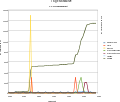Load profile
Load profile , load profile , load curve , load profile line , load-response characteristic or, depending on the time axis, and daily or seasonal cycle designate in the electricity industry or power the timing of the accepted service (for. Example, the electric power or the gas power) over a time Period. The load profile is usually subject to strong fluctuations during the day, which in turn vary depending on the day of the week and seasonally.
electricity
Since electrical energy can only be stored to a small extent and with losses , electricity trading , electricity transport and electricity generation must follow the fluctuations in consumer loads over time, or the loads must be adapted to the available power by means of consumer measures or remote control of the supply network operator (DSO).
Electricity trading as the provider of the energy quantities (“energy only” principle) takes place on the one hand via long-term contracts for basic supply and on the other hand via the electricity exchange .
The electricity generation must cover the actual energy demand through power plant management . Base load and peak load power plants are available for this, which differ in the time it takes to start up and shut down. Peak load power plants work z. B. with gas turbines to drive the generators and can be operational within a few minutes.
In the liberalized electricity market, knowledge of the load profile of a customer is of particular importance for the DSO and electricity traders. Therefore, the actual load profiles are measured for consumers with an annual consumption of more than 100,000 kWh / a. In these cases one speaks of the measured load profile. For this purpose, remotely read 1/4 h load profile counters are used. The data from the measurement are read out once a day by telephone or radio.
For consumers with a lower annual consumption, the load profile measurement is too complex. So-called standard load profiles (SLP) exist for these consumers . Here, the consumption behavior of a typical end user over time is substituted by standardized customer group or industry-related consumption patterns. A load profile for these small consumers is approximated by weighting with the estimated (forecast) or measured (accounting) annual work volume. A distinction is often made between weekdays, Saturdays and Sundays (typical days) and sometimes between three seasonal areas (transitional seasons, summer, winter). so that there are a total of nine typical standard time of day profiles. Important changes will result from the “ smart meters ” that have been mandatory since January 1, 2017 .
Gas supply
Load profiles are also used in the liberalized gas market.



